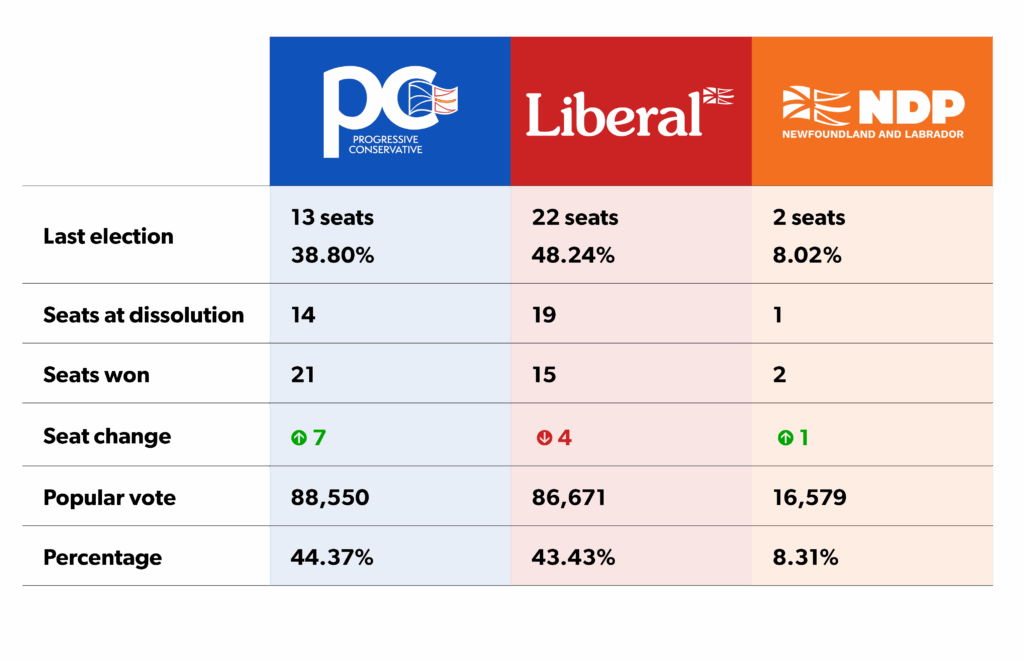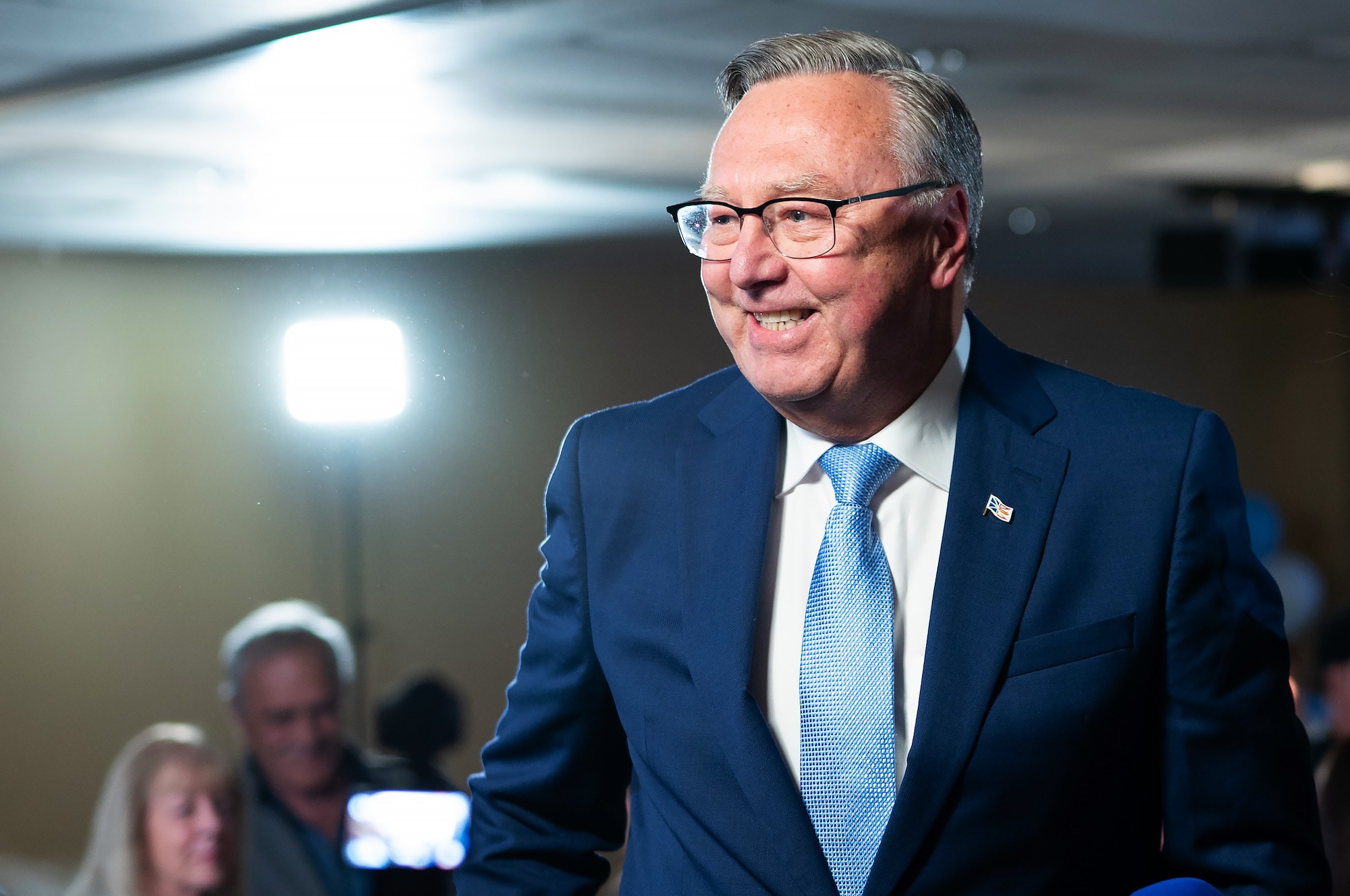A tale of two narratives
In the October 14 provincial election, Tony Wakeham’s Progressive Conservatives formed a majority government in Newfoundland & Labrador with 21 seats to the Hogan Liberals’ 15. There were also 2 NDP and 2 Independent MHAs elected. The PCs held all their incumbents and gained seats throughout rural Newfoundland as well as Lake Melville and Labrador West in Labrador.
The Liberals ran several incumbent or recent municipal politicians to try to retain seats where incumbents weren’t running again as well as to challenge some of the PCs. This approach was met with mixed results.
While publicly released polls were absent for most of the campaign (and most of 2025), the few that were released forecast two very different possible outcomes of this election. One narrative was that this was going to be a landslide for the Liberals, though many commentators of all stripes and leanings challenged the methodologies of these surveys. The other surveys and/or analysis (including ours) was revealing a much closer race, which better fit the experience and feedback all parties received as they campaigned.
Campaign cut and thrust
It was a close campaign, and at times even heated. Incumbent Grand Falls-Windsor–Buchans PC MHA Chris Tibbs faced a near physical threat and confrontation from his Liberal opponent Barry Manuel, who was angry over Tibbs’ assertion that Manuel and his camp lied about Tibbs work schedule. It took 10 minutes to get on with the forum. In the end, Tibbs was re-elected with 59 per cent of the vote in the district.
Labrador West, initially thought to be a three-way race, turned into a close battle between the Liberals and the PCs, with PC Joe Power edging out his Liberal opponent Todd Seward. This gave the PCs three of Labrador’s four seats in the Assembly. Labrador West was one of the five closest district wins for the PCs. The closest, likely on its way to a recount was PC Mark Butt’s 18 vote win over Liberal Derek Benett in Lewisporte Twillingate. In the five closest PC-won districts, just over 500 votes made the difference between a PC majority and a Liberal majority.
In St. John’s and its suburban areas, Liberal vote percentages actually climbed. PC incumbents in these areas and even farther out on the Avalon peninsula in commuter communities faced much stronger challenges from Liberals and the results were closer in these districts. Several districts ping-ponged between the two major parties all night, with NTV at one point projecting no majority. These upticks in areas of relative Liberal strength in recent years meant that the Liberals came close to winning the overall popular vote. The PCs received 88,550 votes to the Liberals’ 86,671, a difference of just 1,879 votes. The NDP received a total of 16,579 votes.
Changing regional political landscape
Generally, the rural parts of the province wanted a new government, whereas in many major towns and the capital, there was still a lot of comfort with the Hogan government. The results of this election also further reinforce trends noticed in the 2025 federal election. Off-Avalon, rural Newfoundland is accessible and open to conservative parties. Meanwhile the Avalon, especially St. John’s experiences issues fairly differently and people have been drawing different conclusions. This may sound like a normal phenomenon in many provinces, but it represents a possible inversion from the post-Confederation landscape where the strongest Tory territories were in the capital and on the Avalon. That landscape existed for decades until more recent elections.
Canadian Conservatives join in the NL effort
The PC campaign imported professional help from conservative campaign strategists from other parts of Canada. This was a departure from a more insular campaign approach in the past. In recent years, the party has elevated its campaign approaches: first on digital and social media, but also in strategic communications, such as the timing of platform announcements. They also brought a uniform approach to voter ID, candidate support, the Leader’s tour and the Leader’s debate preparation.
When asked about his relationship with Pierre Poilievre and the Conservative Party of Canada, Wakeham was always careful to be clear that the PC Party of NL is its own party. However, he did acknowledge a lot of common ground on policy:
“There are things that the federal Conservatives have stood for, including the removal of that emissions cap. Do I agree with that? Absolutely,” Wakeham said while speaking at a campaign event in St. John’s last week.
“Do I agree when they talk about the development of our offshore oil? Absolutely, 100 per cent. Did I agree with their removal of the carbon tax? One hundred per cent. So, there are lots of things that we agree with and that we will continue to fight for.”
Federal NL Conservative MPs Clifford Small, Carol Anstey and Jonathan Rowe all pitched in and canvassed with provincial PC candidates in the districts within their respective federal ridings. The overlap in activist and donor support is also much more like it was generations earlier.
Now what?
Expect change, but also a methodical straight-laced approach. Premier-elect Wakeham has served as a Deputy Minister in the provincial government, and “process, propriety and transparency” have all been themes he speaks about in interviews.
The Churchill Falls MOU will undergo a full independent review, and given the position further defined by Wakeham since January, there will be a strong emphasis on the review body’s independence from the government. There are also implications that flow from this in terms of timing. The Legault government in Quebec has a year left and is presently not popular enough for re-election. Negotiation dynamics likely change not only because of the NL election, but also because of Quebec’s impending election, which could see a Parti Quebecois government elected. (Quebec did come up during the campaign when Wakeham raised Quebec newspaper reports that Quebeckers were asked to conceal their happiness with a deal that was so good for their province).
Cost of living, public safety, services (especially health care) and the Upper Churchill Hydroelectric MOU all featured heavily in the campaign. PC leader Tony Wakeham made an effort to put the Hogan Liberals on their heels over reports of NL Health’s CEO holding a report that includes possible spending reductions in five areas in health care.
There will also be a noticeable change in tone and activity opposing federal policies and laws that affect the NL offshore oil and gas industry as well as NL mining development. The PCs made it clear in the leadup to the campaign and during the campaign that they viewed Premiers Furey and Hogan as virtually silent on these issues and that would have to change. NL’s approach may differ from the Smith and Moe governments, but NL will be very much their ally in the push for repeal of various federal laws and regulations that those provinces have already listed – including but not limited to the emissions cap and Bill C-69.
One area where change may take longer is government finances and structure. The PCs also successfully courted a lot of labour group and union support – this may influence their appetite for reforms in those areas. A future budget may see movement on re-directing some of the $254 million in areas of waste identified by Wakeham in the Leader’s debate, though not likely all at once. Transition will take weeks, as may the announcement of the new cabinet.
The 2025 Election by the numbers

For more insights on the Newfoundland + Labrador election, connect with Senior Consultant Liam O’Brien.
